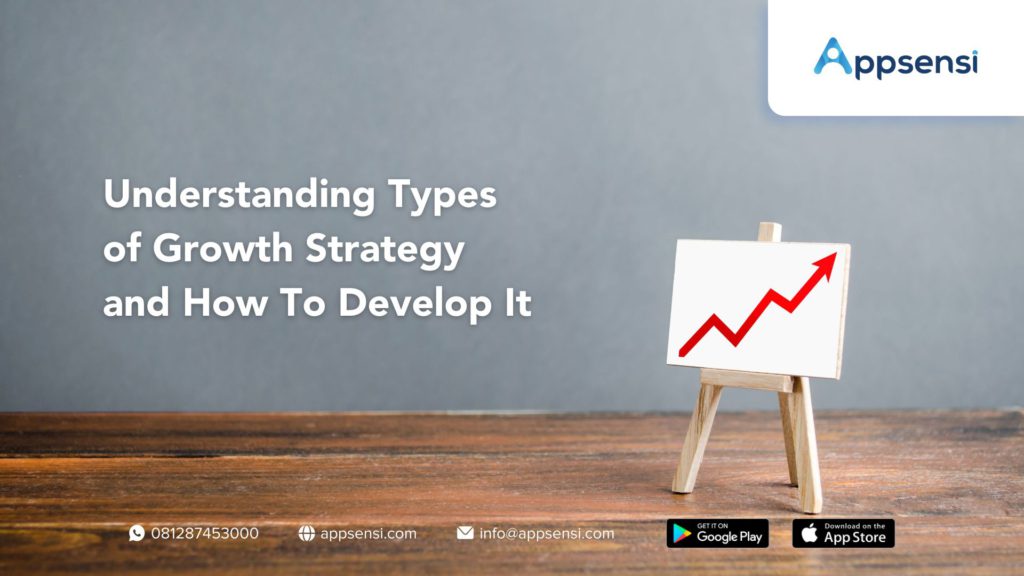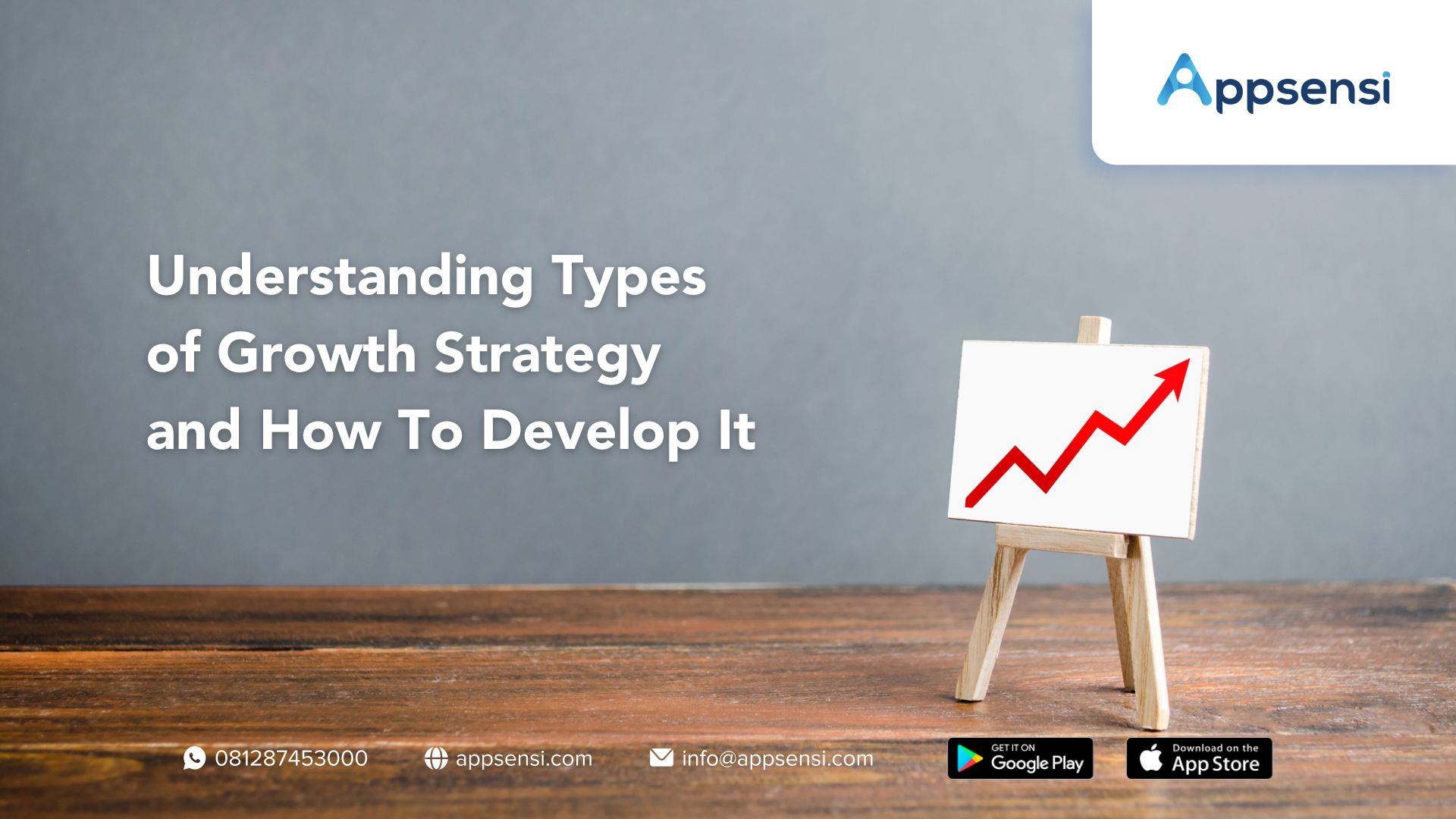A business will increase in level by using stairs, not by elevator. Each ladder rung indicates the challenges that you must overcome in order to advance to the next level. One wrong step will make you have to start again from the beginning.
Each ladder rung represents your company’s growth and your path to success. A good idea is not enough to sustain the company’s business in the long term. A good growth strategy and good planning are needed to maintain the balance of your company’s business.

What a growth strategy is?
A growth strategy is a method adopted by companies to capture a larger market share. This strategy sustains the business in the long term and its formulation goes beyond current market conditions.
The growth strategy formulation is influenced by market conditions, target consumers, market competition, and distribution channels. Analogy your business success to climbing the ladder.
As you climb those stairs, you have to be very careful with the steps you take. There will be competitors who will try to knock you down, hoping you will. Therefore, it is unwise to focus solely on the vision. Or worse, having no vision in mind and climbing aimlessly.
Why is growth strategy important?
A growth strategy gives meaning to your business and provides the direction for your long-term goals. By outlining an action plan in your area to improve your business, you can focus on the future. Growth strategies help improve what is already working well and change the products that need improvement.
Growth strategy and growth hacking
A growth strategy is a long-term process that requires testing with several approaches to encourage business growth in your company. The growth strategy aims to grow the company’s customer base by trying different channels.
Growth strategies tend to move more slowly and steadily. On the other hand, growth hacking produces massive growth in a short period of time and is an inexpensive process. Growth hacking focuses on growing the user base quickly and at a low price by performing certain techniques on certain channels.
Also read: How to Create the Perfect Business Development Strategy
Types of growth strategies

These are several growth strategies that can be carried out by companies such as:
1. Market penetration strategy
What is a market penetration strategy? Market penetration strategy is a strategy in which the company seeks to increase sales of its products and services (increase market share) in the market that the company has entered. By using a market penetration strategy, the company does not try to be part of a new market.
However, it dominates the existing market. To achieve this goal, the company can spend on the needs of product promotion, product quality improvement, etc., to attract a larger market margin.
Market penetration strategy is a strategy that companies are looking for because it has the lowest risk. In order for a market penetration strategy to be successful, a company must have detailed market knowledge and the activities of its competitors.
There are several approaches that can be adopted by companies wishing to pursue in this strategy:
- Maintain and increase the market share of existing products with competitive prices, advertising, and promotions.
- Dominate a growing market. Companies must identify a new demographic group for their products and services such as consumer age.
- Restructuring mature markets by shifting competitors’ positions. Companies that are already in a mature and saturated market need a different approach to increase their market share. The restructuring was carried out by aggressive promotional campaigns, setting prices that made the market unattractive to smaller competitors. This is done because, in a mature market, there is no longer any demographic group that can be exploited. The only way to increase market share is to seize it from competitors.
- Drive product usage by existing customers by persuading customers to use your company’s products and services more often. It uses a loyalty scheme by adding value to existing products, and changing the product in such a way that it can make customers use your products and services more.
2. Market development strategy
Do you know about market development strategy? A market development strategy is a strategy in which a company tries to attract new customers with its existing products. By using a market development strategy, e-companies try to attract customers in the already entered market by targeting new market segments or by entering a new market (geographical expansion). Here are some ways to carry out a market development strategy:
Doing geographic expansion
Geographical expansion is carried out by the company by trying to enter a new market in different areas from the market the company normally resides. The new market can be outside the region, abroad, or even outside the continent. The level of risk of this strategy depends on the company’s ability to build sales channels in the new markets it enters.
Product dimensions or packaging updates
Renewal of product dimensions or packaging can be carried out by companies to open new markets. For example, small packaged cooking oil is ideal for distribution in the household market and large containers such as drums are ideal for distribution in large industries.
New distribution channel
Creating new distribution channels can be done by selling through online marketplaces and not a few small retailers selling online.
New pricing
The new pricing policy was implemented to create new market segments. Using this strategy, you can find out if your current customers are easily switching their purchases to take new pricing advantage.
3. Product development strategy

Product development requires changes in the operational aspects of the business including the research and development (R&D) functions needed to introduce new products to the existing customer base. The following conditions must be met to use a product development strategy:
Research and development
To carry out your product development, your company must find out and assess various application aspects of new technologies, processes, and materials.
Assess customer needs
Assessing customer needs is an initiative that can be carried out by the marketing division by distributing surveys in the form of questionnaires to customers or forming consumer groups to gather information from them.
However, keep in mind that customers’ needs can be identified by people who have direct contact with customers such as salespeople and customer service staff. By doing so, companies can understand what the real needs of their customers are and how their understanding could be interpreted into product development.
Brand extension
It is common for companies to launch new products by using their existing names to be attached to new products in different categories. Companies that do brand extensions hope to benefit from their customer base and brand loyalty. However, this has a fairly high risk. If it fails, the parent brand could be negatively impacted.
Acquisitions
Many large companies use this method to buy competitors or buy companies that have the technology they need to run their businesses. Small businesses may shy away from it, but if you have the capital and can buy a business that benefits your business, consider it.
4. Diversification
The diversification seeks to create growth by developing new products intended for completely new markets. This is much riskier when you compare it to a product development strategy. The company certainly has little or no experience with this new market.
The diversification requires new skills in marketing and operations that require a large investment. This kind of investment could be done in the form of acquisitions of other companies that have been in the new market for a long time.
Companies that want to adopt diversification are required to have a clear growth idea they want to achieve. Your company also carries out an honest risk assessment involved. In its application, diversification often fails because your company relies on products that are not competitive in the market and are shrinking.
However, for companies that are able to manage risk well, diversification can open up business growth. Diversification may be divided into further categories:
Horizontal diversification
This is the purchase or development of a new product by a company intended to be sold to an existing group of customers. These new products often have no technical or commercial relationship with the current product, but can appeal to current customers. For example, a company that used to make notebooks can enter the pen market with new products
Vertical diversification
A company falls into the realm of suppliers or customers. For example, if you have a business that rebuilds your home or office and you start selling paints and other building materials for that business.
Concentric diversification
Concentric diversification involves the development of new product lines or services that have technical and/or commercial similarities to existing product lines. This type of diversification is often used by small producers of consumer goods. For example, bakeries start making pastries and pasta.
Conglomerate diversification
Move to a new product or service that has no technical or commercial relationship with your current product, device, or distribution channel, but may appeal to new customer groups. The main motivation behind this kind of diversification is the high rate of return on investment in new industries. It is commonly used by large companies looking for ways to balance circular and non-circulating portfolios.
Also read: How Much Do You Know About Strategic Planning?
Growth strategies alternatives
There are several alternatives to the growth strategy, namely:
1. Horizontal integration strategy
By using a horizontal integration strategy, companies can acquire companies that are competitors or have the potential to become competitors. Not only does it provide fuel for growth such as efficiencies due to economies of scale, but it also has the potential to pave the way for further growth by eliminating competitors.
2. Upstream integration strategy
Companies that use an upstream integration can acquire or establish a company that is their supplier so that company is able to control its supply chain. That way, it can help companies develop new products more quickly and cheaply.
3. Downstream integration strategy
Companies that adopt a downstream integration can acquire or establish companies that are part of their distribution chain. That way, it can help cut distribution costs, speed up the distribution process, and so on.
How to develop growth strategies

1. Market analysis
You need to understand the customers you want to serve, market conditions, and the services offered by your competitors to get a clear picture of the services you can offer. You need to do a competitor analysis and understand consumer demographics to give you an idea of where you stand when you enter the market.
Often competitors do not meet consumer needs. However, consumers continue to use the product or service of a brand because of the lack of alternatives. That way, your business can gain an edge here by offering products and services that competitors don’t have.
It is important to understand consumer needs and identify areas of weakness for your competitors for your company’s business to succeed. Competitive analysis can also help you determine areas you can serve better and areas you can explore. Competition can cause failure if not monitored carefully.
Also read: Market Research 101: The Ultimate Guide for Your Business
2. Long-term growth strategy
After conducting a market analysis, you will have a clear idea of the products and services that your business offers. The next task is to decide which long-term growth strategies you want to adopt. The following are realistic examples of growth strategies.
Network effect
One of the examples here is the network effect is a product or service that increases in value as more people use it. These are six strengths of the network contribution of the network effect, namely,
- Buyer to seller cross side
- Buyer same side
- Direct to buyer
- Seller to buyer cross side
- Seller same side
- Direct to seller
When you have used network effects to increase consumers. Companies will conveniently model these growth channels and define their quantitative metrics. segmentation using this model makes decisions based on data and identifies which channels to invest in to maximize profits.
You can select your main market segment as a niche market and plan a gradual expansion through network building on the market. To convince people to use the products and services that your company offers, you can do the following,
- Provide the best service to customers
- Define your value proposition
- Make sure your system can handle the changes.
The network effect develops positively for a company if its consumers derive the inherent value and network value after consuming and referring to the product.
Face-to-face approach
The face-to-face approach refers to increasing brand awareness and use by contacting potential customers directly.
Free product strategy
The free product can invite all major stakeholders to try the products or services that a company provides through this.
Referral bonus strategy
The referral bonus has the aim of providing incentives to customers for company growth. Initially, this requires a high capital investment. However, the company will reap considerable profits if it is done after going through proper research on this.
3. Measuring growth
Once you have a strategy that you want to adopt for the company, the next thing you should do is share your company’s vision with all employees in the whole company. Break long-term strategies into annual to monthly plans to make growth easier to achieve.
The strategic plan will force your team to consciously take into account the internal and external factors that affect the business. Setting KPIs can also support and influence business goals. KPIs will show how effectively you are working towards the goals you set.
Maximize your growth strategy with Appsensi
No matter what industry you’re in, climbing to the pinnacle of success will never be easy. Therefore, it is important not to forget your goals and keep climbing, one rung of the ladder will have different problems and solutions, therefore a growth strategy will be very useful for your business.
Most likely there will be expenses in every strategy that you will do. Make sure all these costs are recorded properly so you can measure every action you have taken based on the value you have spent. Feedback from multiple parties can help you pinpoint areas for improvement and also help you make assumptions about your target audience.
Employee performance is one of the things that define a company. Based on their presence, their activities, and the outcome of their work, these things can affect the company in many ways. Especially during a pandemic, there are many changes in the corporate system that can affect employee performance.
One of them is the attendance system. In this pandemic era, more and more offices are adopting telework policies to reduce the risk of spreading the virus in the workplace. For this reason, many organizations need to migrate their attendance systems from fingerprint devices to online attendance systems.
Appsensi provides enterprises with secure access to attendance data monitoring with facial recognition and location detection (GPS) capabilities. Appensi not only manages your company’s attendance data, but also provides a variety of features to help your company. Some of these features are smart CCTV integration, payroll systems, earned wage access, performance management, custom integration, and performance.
Looking for more solutions that suits your company and business? Appsensi is here to help you click here to find out more.
[hubspot portal=”8748271″ id=”29889827-c326-4eca-a8ae-0932fde56f6b” type=”form”]







Tulis Komentar